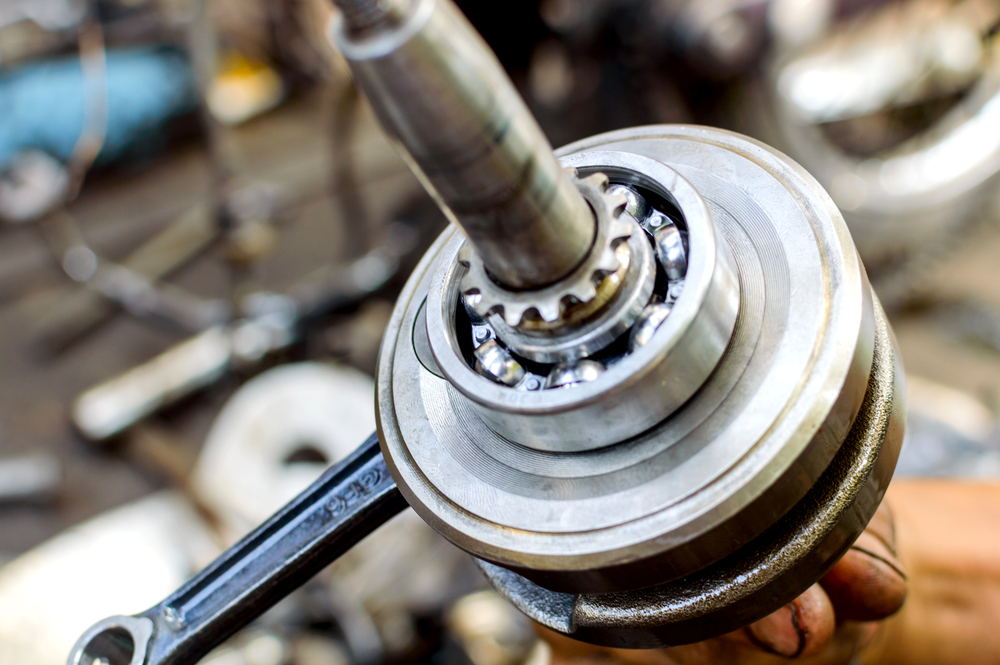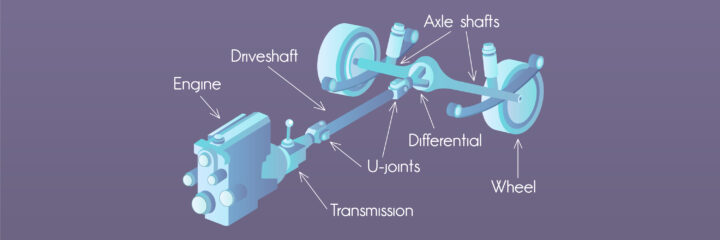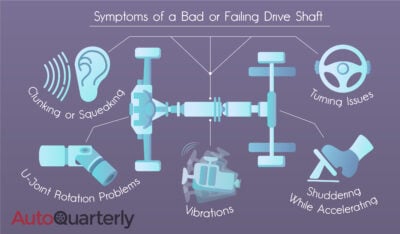The drive shaft of your vehicle is essential when it comes to controlling or driving your car. Without a properly functioning drive shaft, you may find yourself at an increased risk for accidents or injury as a result of this lack of control. If you suspect that a bad or failing drive shaft is causing issues for you, then you need to carefully examine the symptoms you are experiencing in order to get to the bottom of the problem.
In this article, we will discuss the most common signs of a bad or failing drive shaft. We’ll also discuss what to do if you think a bad drive shaft is causing problems for you and how much you can expect a replacement of a bad drive shaft to cost you. Read on to learn everything you need to know.
How Does the Drive Shaft Work?
A drive shaft, also sometimes called a drivetrain, is a cylindrical shaft that works to transmit torque from the engine to the wheels; it consists of a propeller shaft, universal joints, and slip splines and yokes. This is essentially what drives your vehicle, as without the torque being transmitted to the wheels accurately, the drivability of the car is affected.
Drive shafts are found on four-wheel and rear-wheel drive vehicles almost exclusively and are very precisely balanced and weighted. Front-wheel drive cars have something similar called a half-shaft.
Because your drive shaft system rotates at very high speeds and transmits torque at varying angles between the driveline components, it is essential that the shaft is in good condition and completely flexible, or it won’t be able to properly complete these tasks.
Signs You May Have a Bad or Failing Drive Shaft
These common symptoms of a bad or failing drive shaft should be something you look out for if you suspect that your drive shaft is starting to have issues.
Vibrations
One of the most recognizable signs of a bad drive shaft is vibrations. If you are driving your car and there are harsh vibrations coming from it that start to rattle the steering wheel, you may have an issue with the drive shaft. This is typically due to worn-out bushings of the drive shaft, as the bushings are usually what keep the drive shaft from vibrating.
You should not ignore any type of vibrations coming from your car, as the bushing is likely to only get more worn out over time and the vibrations worse. This vibration can also affect other parts of the drive shaft or your vehicle.
However, if you notice that vibrations only occur when you reach high speeds, your tires may need balancing, which can be a lot easier to deal with than a bad drive shaft.
U-Joint Rotation Problems
The u-joint, also known as the universal joint, it supposed to rotate at a steady pace, allowing the drive shaft to function as normal. When the u-joint moves too fast or too slow, it can cause issues with the drive shaft and lead to a loss of control over the car.
In some cases, damage on the u-joint can be so significant that you have to replace the entire drive shaft to get your vehicle driving properly again.
Turning Issues
Another key sign of a bad drive shaft is when you have an issue turning your vehicle. If you try to make a turn and the wheels don’t move immediately or hesitate in some way, this is a definite sign of a bad drive shaft.
This hesitation is caused by a lack of torque being transmitted from the drive shaft and u-joint, leading to extra resistance that the tires have to fight against to turn properly. This can be a very dangerous symptom, so if you are experiencing this you may want to seek professional help as soon as possible.
Clunking Sounds
If you begin to hear clunking sounds when you accelerate, place your car into drive, or into reverse, you may be experiencing a bad drive shaft. This type of clunking sound typically means that the slip yoke of the drive shaft is not functioning correctly.
Shuddering While Accelerating
Vehicle shuddering or shaking that occurs when you try to accelerate from a stopped or low speed position can indicate a bad drive shaft. It typically indicates a faulty u-joint or an issue with the center bearing of the drive shaft.
Squeaking Noises
Squeaking sounds that are present while driving and won’t go away could indicate a bad drive shaft. Typically, these noises are caused by damaged bushings in the drive shaft, an issue with a u-joint, or general imbalance. You may notice that the squeaking noise gets louder the faster that you drive.
However, you shouldn’t confuse this squeaking sound with the type of squeaking noise that can be present when you have a slipped or loose alternator belt. You may want to look for other symptoms that confirm the possibility of a bad drive shaft before seeking repairs.
Can You Keep Driving With a Bad Drive Shaft?

You may be able to drive with a bad drive shaft if you are not experiencing the most severe symptoms, but it is not recommended. Continued use of a bad or failing drive shaft may end up with the drive shaft breaking down completely or snapping off, stopping the forward motion of the vehicle or causing you to completely losing control. These things can easily result in an accident or serious injury.
Additionally, a drive shaft breaking down while you are driving may disconnect to one side. As it does this, it will continue spinning momentarily and can take out anything on the underside of your car that is in its way, including brake lines, fuel lines, and wiring. Obviously, this is very dangerous and can result in a complete loss of your vehicle if the damage is bad enough.
Can You Replace a Bad Drive Shaft Yourself?
If you have a lot of experience working with cars and all of the necessary tools already, you may be able to purchase the necessary parts and replace a bad drive shaft yourself. However, this is not recommended for most people, as the drive shaft is such an essential part of your car that replacing or repairing it improperly can cause significant damage or a potential accident.
This article can help guide you through the process of fixing your bad drive shaft at home if you are experienced and prepared enough to try it out.
When to See a Professional About a Bad Drive Shaft
For most people, the best first step to take when experiencing one of the symptoms we discussed above is to consult a professional about it. A mechanic will be able to properly diagnose your issue, evaluating whether it is caused by a bad drive shaft or not, and will be able to accurately advise you on repairs and costs.
Bad Drive Shaft Replacement Cost
Replacement costs for a bad drive shaft range from several hundred dollars up into the thousands of dollars, depending on your vehicle type and how badly damaged the drive shaft is or if you need a complete replacement.
For a front-wheel drive car, a half-shaft replacement cost will start at around $320 and go up to approximately $750 in parts, with labor costing an extra $150 to $190. You can expect more expensive labor prices at something like a dealership, as opposed to a local mechanic.
In rear-wheel and four-wheel drive cars, you can expect to pay anywhere between $600 and $2,000 for both parts and labor, depending on how badly the drive shaft is damaged. A full replacement of the drive shaft in this type of vehicle is likely to be on the more expensive end, while small repairs or replacements will cost less.
Regaining Control of Your Car
Experiencing something like a bad drive shaft can be scary at first, especially if you aren’t too sure what is causing your car problems. Once you understand the symptoms of a bad drive shaft and compare them against your car’s issues, you can make an appointment to consult with a professional in order to get your car issues properly diagnosed and a repair underway. And as soon as your drive shaft is fixed up, you’ll be able to regain control of your car and drive safely once again.



